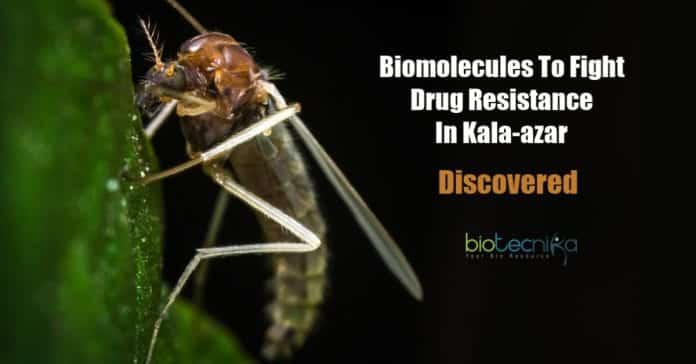Scientists discover new biomolecules to combat drug resistance in Kala-azar
Leishmaniasis is an overlooked tropical disease impacting almost 100 nations including India. A parasite called Leishmania causes this disease, which is transmitted through the bite of sandflies.
3 main types of leishmaniasis:
1. Visceral – one of the most serious types of the disease and it affects multiple organs.
2. Cutaneous, is the most common type and causes skin sores.
3. Mucocutaneous, which causes mucosal and skin lesions.
In India, Kala-azar is the common name of Visceral leishmaniasis, if left without treatment causes death in over 95% of the cases. Miltefosine is the only drug available against leishmaniasis, because of emerging resistance to this drug as a result of a decrease in its accumulation inside the parasite, which is necessary for the medicine to kill the parasite, its quickly losing its effectiveness.
In carrying miltefosine into and out of the parasite’s body, which consists of a single cell – A major function is played by a certain type of protein molecules, called transporter proteins. A protein called ‘P4ATPase-CDC50’ is responsible for the intake of
the drug by the parasite, and another protein, called ‘P-glycoprotein’ is responsible for the intake of this drug out from within the parasite’s body.An increase in the activity of the last leads to fewer quantities of miltefosine being accumulated inside the parasite’s body, and reduction in the activity of the former protein, therefore triggering it to become resistant to the medication.
Scientists at the Department of Biotechnology’s National Centre for Cell Science (DBT-NCCS), Pune, led by Dr. Shailza Singh, has been checking out methods to tackle the drug resistance of miltefosine. Leishmania major – the species of Leishmania that cause infection, were used by the scientists for the study. The scientists attempted to manipulate these transporter proteins in the species in a way that would certainly result in increased uptake of the drug and decrease in its being thrown out of the body of the parasite.
While seeking to manipulate the transport proteins the scientists need to be extremely careful. From bacteria to mammals, including humans – they exist across a diverse range of microorganisms, and more harm than benefits could be caused if any kind of mishandling is done. Subsequently, though many scientists have been working to battle drug resistance, however, their activities were restricted to laboratory researches for over the past 20 years.
Small molecules, called peptides were designed using computational methods by Dr. Singh’s research group, the peptides could very specifically interact with the transporter proteins of Leishmania major alone, and not interfere with human proteins in any way. The peptides were developed to modulate the transporter proteins “allosterically”, i.e. by interacting with the protein molecule at a location apart from the certain location where miltefosine binds to it.
Using computationally-designed synthetic peptides for allosteric modulation of transporter proteins of Leishmania was first shown by this research team. These favorable study results indicate that this method can prove useful to develop novel therapeutics against Leishmania parasites which are drug-resistant.
The outcomes on the study of new biomolecules to combat drug resistance in Kala-azar is published in the ‘Biochemical Journal’.
Author: Sruthi S






























